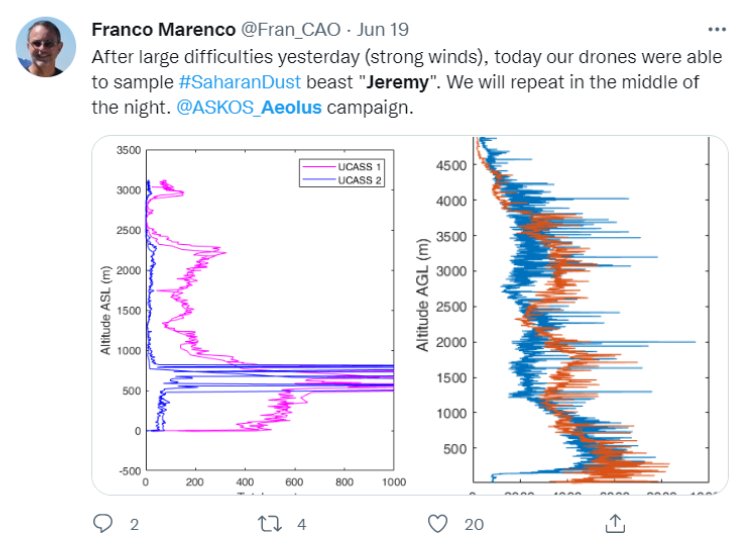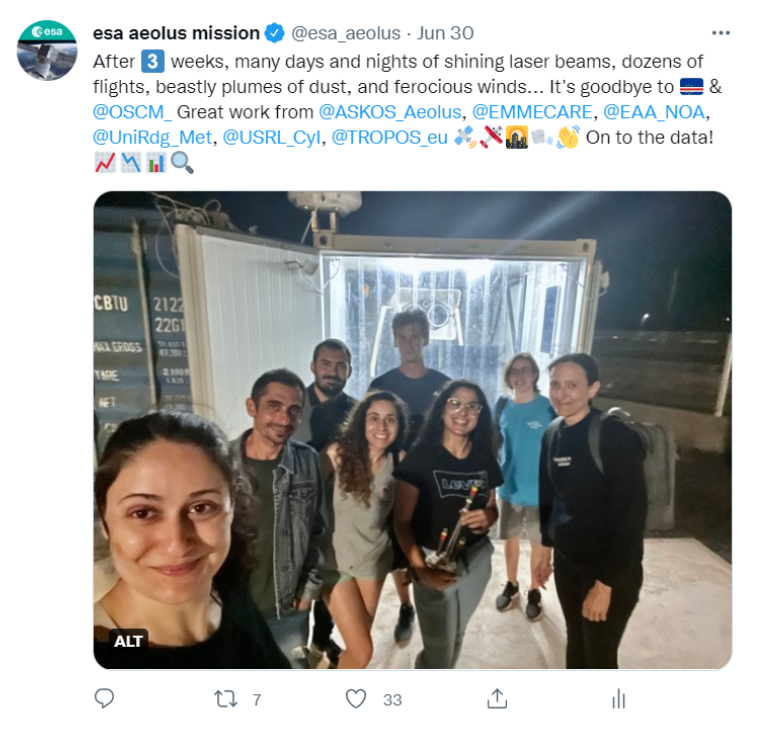Why do we care about dust? And not the stuff you see people dramatically blowing off old library books in films, but the tonnes of particles picked up by the wind from places like the Sahara Desert.
Dust has broad ranging impacts. Aviation, solar power and human health are all negatively impacted by dust. Dust can alter the reflectivity of clouds and the atmosphere, creating a cooling effect at the surface. Windblown dust can also provide minerals and nutrients to wherever it is deposited. The Amazon receives as much phosphorus from the Sahara as it loses each year from being washed away by rain.
Introducing the ASKOS Aeolus field campaign
Between 10th-30th June 2022, the Ocean Science Centre Mindelo (OSCM) in Cape Verde was filled with a collection of scientists from multiple institutions, including the National Observatory of Athens, the Cyprus Institute, the University of Reading, the National Research Council of Spain (CSIC) and the Leibniz Institute of Tropical Research (TROPOS), brought together to work on the ASKOS field campaign.

Credits: National Observatory of Athens
Why Cape Verde? Well, it just so happens to be directly in the passage of lots of atmospheric dust, blown west from the Sahara desert.
This campaign was set up to calibrate and validate the aerosol, cloud and wind products of the Aeolus satellite, ESA’s unique wind lidar mission that launched in 2018. Aeolus primarily uses laser pulses to measure the velocity of wind, but it can also be used to measure particles in the atmosphere.
Ground-based remote sensing instruments and unmanned aircraft equipped with measuring equipment were used to observe Saharan dust in the atmosphere above Cape Verde, often timed with the overpass of Aeolus for a direct comparison. A specific scientific goal of this campaign was to measure atmospheric dust alignment and electrification.
Coarse dust
In addition to the main campaign objectives, Dr Claire Ryder and I (Department of Meteorology, University of Reading) had our own scientific goals during the campaign regarding the largest dust particles.
Field campaigns from the last decade have revealed that giant dust particles (>20 um diameter) travel longer distances than we expect them to. Coarse dust particles have different impacts on the Earth system compared to finer dust particles. The presence of coarse particles increases longwave heating and decreases the shortwave cooling at the top of the atmosphere. Coarse particles also carry more nutrients due to their greater mass. Though we have been able to observe these larger particles travelling further than we expect, we are still unsure how.
One mechanism which has been suggested to increase transport distance of coarse particles is through convective vertical mixing within the Saharan Air Layer (SAL), which is usually between 2-6 km above sea level by the time it reaches Cape Verde. Convective mixing throughout the SAL during the day could mix coarse particles higher into the SAL, therefore increasing the time taken for the particles to reach the surface, encouraging long-range transport. With the removal of the mixing driving force at night, the coarsest particles are expected to sink lower in the SAL than the finer particles.
This is the driving motivation behind my research with the ASKOS campaign.
Helium and hiccups!
In Cape Verde we wanted to fly particle size counters through the depth of the SAL in the day and night to see if there would be any change in the size distribution. This required a number of instruments, flown by the Unmanned Systems Research Laboratory of the Cyprus Institute. One of the drones we used could only reach ~3 km altitude by itself, so we planned to lift the drone with the help of a helium-filled weather balloon up to 6 km before releasing it to glide back to the ground.

The CoBi UAS: an unmanned aircraft carrying equipment to measure dust. – Credits: USRL, Cyprus Institute
What I’ve learnt from being involved in a field campaign is that no matter how much you prepare, something will always go wrong, and plans will have to be changed! Luckily having a great team around us made life a lot easier when things didn’t go quite as planned.
Our first issue arose a week before I was flying out to Cape Verde. The helium tanks which we needed for our balloons had been stopped at customs in Lisbon and wouldn’t be arriving until at least 11 days after the campaign started.
(More on that later…)
What does a field campaign look like?
Each day followed a similar pattern; go to the office at OCSM and check the forecast for the next couple of days in order to plan flights based on when the most dust would pass over, as well as when wind speeds and cloud cover would be lowest, and then keep checking the forecast throughout the day for any unexpected changes.
If we had arranged with the airport to do drone flights, some of the team would go to complete these while others stayed at OSCM to check the real-time observations and inform the airport team if there were going to be any particularly interesting layers in the atmosphere to measure. However, as I said, something will always go wrong (especially when you’re working with the weather!)…
Monday 13 June – the winds are picking up
We had planned for flights to go ahead from 17:15. Dust aerosol optical depth (AOD) was expected to be between 0.3-0.5, with dust extending up to 6 km altitude and relatively cloud-free skies, meaning we could synchronously collect data from the drones and the ground-based instruments at OCSM.

Credits: Franco Marenco, Cyprus Institute
17:26 A scheduled commercial flight from the airport had been delayed and finally took off meaning our team could get onto the runway.
17:39 The team are in final preparations for the first flight of the evening.
17:50 Strong winds mean that the team haven’t yet found a gap in the wind suitable for take-off. Additionally, there are now some technical issues to negotiate back at OSCM with one of the lidars.
18:48 Still no take-off. Maria Kezoudi (of the Cyprus Institute) jokes “We are in Wind-elo, Cape Verde”.
19:41 Eventually the airport team discusses with the rest of the campaign team whether today’s flight session should be cancelled as there are no breaks in the wind.
Tuesday 14 June – the winds keep on blowing!
Nearly perfect conditions for measuring dust today. AOD of ~0.6. Clear skies. If only it weren’t so windy still! The airport records wind speeds throughout the day up to 34 kts.

Credits: Claire Ryder
Friday 17 June
An open day is held at OSCM where students from the local university (Universidade Técnica Do Atlântico) attend lectures given by the ASKOS scientists about the work we were doing, as well as being given a tour of the ground-based instruments.

Group picture – Credits: Eleni Marinou, National Observatory of Athens
Sunday 19 June – Jeremy, a beastly plume!
A large dust plume (which we named Jeremy) is moving across the Cape Verde islands, providing an amazing opportunity for observations.
14:35 First drone is able to take off and travels to near the top of the SAL.
17:00 Second drone takes off and is also successful.

Credits: Franco Marenco, Cyprus Institute
Monday 20 June – more dust!
Due to the continued supply of dust from the Sahara, a push is made by the team to complete overnight flights too.
02:40 Drone carrying an instrument designed to measure particle orientation takes off.
04:00 Second successful flight of the night.
04:55 Third and final flight of the night takes off.

Credits: Sergio Rodríguez, AEMET
Drumroll please…
On the afternoon of the 20th, we heard that the helium had finally arrived in Cape Verde!

Monday 27 June – crashing back down to Earth
03:00 A gust of wind means that one of the drones is pulled down and hard-lands on its belly. This drone won’t be able to fly for the rest of the campaign.
A great team effort, and lots of dust to analyse
The campaign came to a close on the 30th of June and it’s fair to say that there was a lot that didn’t go quite to plan during this campaign from varying illnesses (covid, stomach bugs and back pain) to broken equipment, unpredictable weather and delayed helium deliveries.
Yet, this campaign was an incredible opportunity and will provide new data to calibrate and validate Aeolus products, as well as information regarding the vertical distribution of coarse dust particles in the Saharan air layer. We were able to sample dust throughout the depth of the SAL while Aeolus was passing over, as well as synchronously measuring with the Polly XT (TROPOS), Wall-e and eVe (National Observatory Athens) lidars.

Credits: Eleni Marinou, National Observatory of Athens
None of the work we did would have been possible without the incredible effort put in by everyone involved; the long days and nights, the frustration when the weather got in the way of measurements, and then the subsequent collaboration required to get back on track afterwards too.
Now we must wait and see what scientific surprises lie hidden within all the data collected!
ASKOS Aeolus is a campaign involving researchers from a range of European Institutes, including the National Observatory Athens, the Cyprus Institute, the University of Reading and TROPOS. You can see a full list of the collaborators, and more information about the campaign, at the ASKOS Aeolus website. The next stage of the campaign will be another month of experiments in Cape Verde, beginning in September. You can follow the progress of the campaign by following @esa_aeolus and @ASKOS_Aeolus on twitter.
Post from: Natalie Ratcliffe, Department of Meteorology, University of Reading
Editor’s note: This blog article is part of the DAZSAL project that is supported by the European Commission under the Horizon 2020 – Research and Innovation Framework Programme, H2020-INFRAIA-2020-1, Grant Agreement number: 101008004, Transnational Access by ATMO-ACCESS.








Discussion: one comment
A wonderful article Natalie! Thank you!